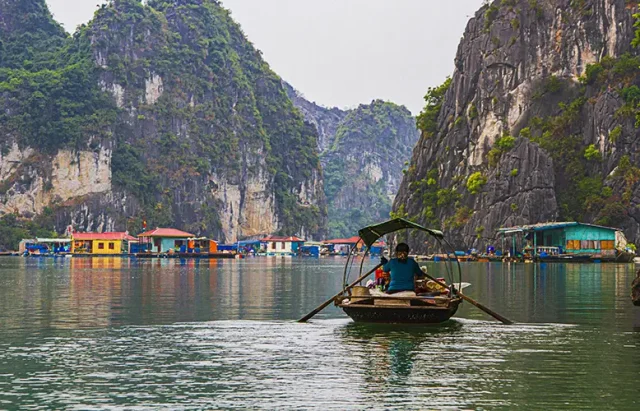
Vietnam has become a highly sought-after destination for travelers from all over the world, especially from Spain. Offering an incredible mix of natural beauty, rich history, and vibrant urban experiences, Vietnam stands out as a must-visit place. In this article, we’ll present you a comprehensive guide to exploring Vietnam’s top tourist attractions and provide essential visa requirement information for Spanish travelers.
Introduction
Vietnam: A World-Class Tourism Destination
Vietnam is a country with a unique blend of picturesque landscapes, bustling cities, and historical landmarks. The Southeast Asian nation attracts millions of tourists each year, thanks to its diverse offerings. From the mesmerizing waters of Halong Bay to the historic Cu Chi Tunnels, Vietnam presents an array of activities and sites that appeal to all types of travelers.
Why Spain Loves Vietnam
Spanish tourists have a particular inclination toward visiting Vietnam due to the country’s exotic appeal, affordable prices, and welcoming atmosphere. The vibrant culture and stunning scenery make it an excellent getaway for those looking to experience something entirely different from their usual European surroundings.
Top Tourist Attractions in Vietnam
Natural Wonders
What makes Halong Bay a UNESCO World Heritage Site?
Halong Bay, located in the northern part of Vietnam, is renowned for its emerald waters and thousands of limestone islands topped with rainforests. This UNESCO World Heritage Site offers breathtaking views and numerous activities such as boat cruises, kayaking, and cave exploration. The bay’s unique geological features and rich biodiversity make it a must-see destination for nature lovers.
How to experience the beauty of Phong Nha-Ke Bang National Park?
Phong Nha-Ke Bang National Park is a paradise for those fascinated by caves and karst landscapes. Home to some of the world’s largest caves, including the famous Son Doong Cave, the park offers guided tours ranging from easy walks to challenging treks. Visitors can explore impressive stalactites and stalagmites, underground rivers, and ancient rock formations that have formed over millions of years.
Historical and Cultural Sites
What can you discover at the Cu Chi Tunnels?
The Cu Chi Tunnels are an extensive network of underground passages used by the Viet Cong during the Vietnam War. Located near Ho Chi Minh City, these tunnels served as hiding spots, living quarters, and supply routes. Today, tourists can crawl through the narrow tunnels to get a sense of the war-time conditions and explore exhibits showcasing the history of the Vietnam War.
Why is the Imperial City of Hue significant?
The Imperial City of Hue is a monumental citadel that once served as the capital of the Nguyen Dynasty. Located in central Vietnam, Hue is packed with historical significance, featuring ancient palaces, tombs, pagodas, and temples. Visitors can walk through the grandeur of the Forbidden Purple City and explore the remnants of Vietnam’s imperial past.
Urban and Modern Attractions
How does the hustle of Hanoi contrast with modern Ho Chi Minh City?
Hanoi and Ho Chi Minh City offer vastly different urban experiences. Hanoi, the capital city, retains an old-world charm with its historic temples, narrow streets, and French colonial architecture. In contrast, Ho Chi Minh City is a bustling metropolis with modern skyscrapers, lively markets, and a fast-paced lifestyle. Both cities provide unique cultural insights and myriad things to do in Vietnam.
What shopping and dining experiences await in Ho Chi Minh City?
Ho Chi Minh City is a shopper’s paradise with an array of markets, malls, and boutique shops. Ben Thanh Market is an iconic spot where visitors can purchase traditional Vietnamese goods, handicrafts, and souvenirs. The city is also a gastronomic hub offering everything from street food to high-end dining experiences, featuring both local specialties and international cuisine.
Vietnam Visa Requirements
Visa Policies for Spanish Citizens
What are the visa exemption rules for Spanish tourists?
For short stays of less than 15 days, Spanish citizens can enter Vietnam without a visa, thanks to the visa exemption policy. This rule applies as long as there is a minimum of 30 days between two visa-free entries. Therefore, it’s important to plan your trip duration carefully to take advantage of this benefit.
How can Spanish tourists apply for an e-visa?
For longer stays, Spanish tourists need to apply for an e-visa. The process is straightforward and can be completed online. Applicants need to fill out an application form, upload the necessary documents, and pay a fee. The e-visa allows for a 30-day single-entry stay. You can find more detailed information and apply for an e-visa at the following link: Where to apply for the eVisa for Vietnam.
General Entry Requirements
What are the passport requirements for traveling to Vietnam?
Travelers to Vietnam must have a passport that is valid for at least six months beyond their planned departure date. Furthermore, there should be at least one blank page in the passport for visa stamps. It’s advisable to check your passport’s validity before making any travel arrangements.
Are there any additional documents needed for entry?
In addition to a valid passport and visa (if required), travelers should have a copy of their travel itinerary, accommodation bookings, and proof of sufficient funds for the duration of their stay. Some travelers may also need to show a return or onward ticket.
Tips for Spanish Travelers
Best Seasons to Visit
Vietnam’s climate varies significantly from north to south, making it essential to choose the right time to visit. The best time to travel to northern Vietnam (Hanoi and Halong Bay) is from October to April when the weather is cooler and drier. Central Vietnam (Hue and Da Nang) is best visited between February and August, while southern Vietnam (Ho Chi Minh City) is most pleasant from December to April.
Cultural Etiquette and Customs
Understanding and respecting local customs can greatly enhance your travel experience in Vietnam. Always use both hands when giving or receiving items, as this is seen as a sign of respect. Dress modestly, especially when visiting temples and religious sites. Remove your shoes before entering someone’s home and avoid touching people’s heads, as it is considered impolite.
The use of English in Vietnam is growing, but learning a few basic Vietnamese phrases can go a long way in endearing yourself to locals. Vietnamese people are known for their hospitality, so returning their kindness with polite behavior will ensure a warm welcome.
Finally, bargaining is common in markets, so don’t be afraid to haggle a bit to get the best prices. However, always maintain a friendly and respectful demeanor while negotiating.
Whether you’re drawn to Vietnam’s natural wonders, historical sites, or vibrant cities, this captivating country offers experiences to suit every traveler’s interests. By understanding the visa requirements and embracing local customs, Spanish tourists can make the most of their visit to this extraordinary destination.





